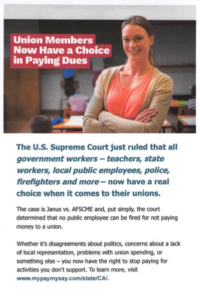More evidence school employees left their unions in late 2018
 “Union members now have a choice”: CPC email, one of 13.9 million communications with California government employees.
“Union members now have a choice”: CPC email, one of 13.9 million communications with California government employees.
Union membership in yet another California school district is down dramatically, providing new evidence of a broader statewide decline in government unions following last summer’s Supreme Court decision in Janus, the landmark labor case.
In 2018, Orange Unified School District documents show, membership among support staff in the California School Employees Association (CSEA) fell a dramatic 13.5% over the same period, from 1,472 to 1,272.
Membership among teachers in the Orange Educators Association (OEA) declined about 3.5%, from 1,391 members in January 2018 to 1,344 in December.
“The district’s numbers show the big declines in both Orange Unified unions came after the Supreme Court’s decision in Janus,” said California Policy President Will Swaim. “While the membership numbers ticked up again slightly at the beginning of the school year, they haven’t returned to early 2018 numbers.”
The declines follow an intense education effort by the nonprofit California Policy Center and its partners, including Michigan’s Mackinac Center for Public Policy. Beginning on June 27, the day the Supreme Court announced its decision in Janus, and until December 31, CPC delivered 13.9 million advertisements to the social media and email accounts of 1.4 million public employees. That communications campaign directed public employees to MyPayMySay.com, a website designed to educate workers about their rights after Janus.
“The education effort is clearly working,” said Swaim.
Swaim pointed to CPC’s audit of union data from Santa Ana. As in Orange, the data showed declines among support staff and teachers. The Santa Ana Educators Association lost about 5% of its membership after the Janus decision. About 10% of Santa Ana’s support staff dropped out in the same period.
The declines in Orange and Santa Ana surprised Mike Reitz, a veteran government union watcher in Michigan.
“These early numbers show that there is a significant appetite among California public employees and teachers to leave unions that aren’t serving them well,” Reitz said. “This is a surprisingly strong start, and it’s just the beginning.”
In Michigan, Reitz notes, membership in government unions dropped less than 1% in 2013, the first full year after Michigan Gov. Rick Snyder approved a law barring mandatory union membership.
“After the first year following Michigan’s passage of right-to-work, unions bragged of losing only a few members and predicted that to be the final case,” said Reitz, executive vice president of the Mackinac Center, California Policy Center’s partner in the California union education effort. “However, since then, Michigan’s largest public sector unions have lost a massive amount of members and revenue. The Michigan Education Association is down 32,000 members, or nearly 33 percent since its peak when the right-to-work law went into effect.”
Declining membership presents a financial and political problem for union leaders.
“When government union leaders have more money, they spend it to support political candidates. Once in office, those politicians naturally feel loyal. They’re very likely to greenlight generous contracts for the people who campaigned for them,” Swaim said. “Contracts approved in that political environment are bound to be like unexploded roadside bombs: We may not feel the pain today, but they’ll cause financial chaos down the road.”
Orange Unified made its documents available to California Policy Center following a public records request by CPC counsel Craig Alexander.
